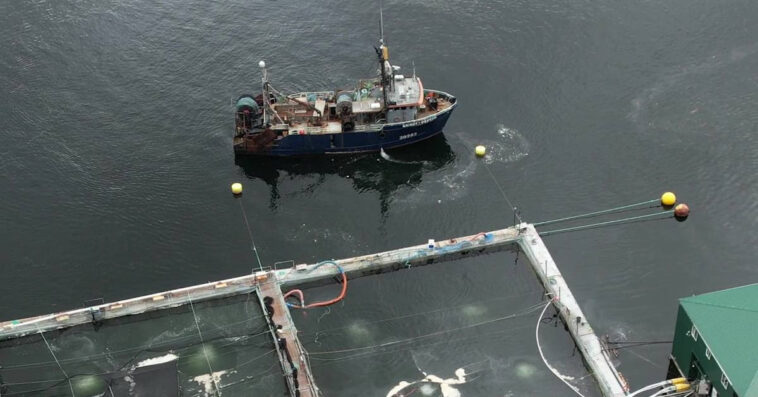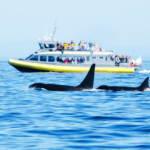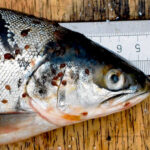Wild salmon experts are saying a fish farm “catastrophe” is taking place within the open-net pen farms in Nootka Sound off of Vancouver Island. Stan Proboszcz, Senior Science and Policy Analyst at Watershed Watch Salmon Society, witnessed plumes of discharge being released into Nootka Sound waters, which he believes is connected to reports of massive fish die-offs taking place at Grieg Seafood fish farms. Representatives with Fisheries and Oceans Canada (DFO) have confirmed that three out of five Grieg facilities in the area reported significant mortality events, the highest being 23% of the stock dead at one farm over a ten-day period.
On May 30, Proboszcz received a tip that massive numbers of ‘morts’ or dead fish were seen in Muchalat Inlet in Nootka Sound. He and his colleague Alexandra Morton decided to investigate further and checked a marine traffic website that showed an unusual amount of vessel activity around Grieg Seafood’s Muchalat North aquaculture facility.
“I’ve seen a lot of fish farms and I’ve never seen all this white crap floating at the top of the farm… You could see plumes of oil, what looked like oil slicks, maybe fish oil coming from the farm as well.”
Stan Proboszcz, Senior Science and Policy Analyst at Watershed Watch Salmon Society
“I tried to arrange a motor boat out there – we knew we had to get out there really fast, and that didn’t really pan out,” Proboszcz said. “And I thought, “I’m just going to kayak out there,” On June 1, which also happened to be BC Wild Salmon Day, he kayaked the eighteen kilometres out to the farm from the Gold River boat launch, taking drone cameras with him to capture any abnormal activity around the farm. What he saw there confounded him.
An older fishing boat was using a massive hose to connect to the farm pens, sucking out and then discharging fluids and unknown white material straight into the inlet. “I’ve seen a lot of fish farms, and I’ve never seen all this white crap floating at the top of the farm. And we were just thinking, ‘What is that stuff?’” he commented. “You could see plumes of oil, what looked like oil slicks, maybe fish oil coming from the farm as well.”
Proboszcz suspects the white material was decaying dead fat and flesh being cleaned out of the pens that hold tens of thousands of farmed fish. Farmed salmon are much fattier than wild fish because they are far less active, contained in their tight pens.
Kayaking back from the Grieg facilities, he saw schools of juvenile wild salmon jumping in the water, leaving him concerned about how they would be impacted by the mysterious discharge being pumped into the inlet nearby.
DFO Confirms Die-off
When he got home, Proboszcz immediately contacted Brenda McCorquodale, Senior Director of Aquaculture Management at DFO. In emails shared with The Skeena, McCorquodale confirms that recent mass fish die-offs had been reported at fish farm sites in Clayoquot Sound, Port Hardy, Clio Channel, Esperanza, and Nootka.
In Nootka Sound, three Grieg facilities reported mortality events to DFO, including a loss of 23% of stock at their Muchalat North farm and 9.5% and 3.8% at the Williamson and Gore farms, respectively. Any mortality events must be reported to DFO if they reach a threshold of 1% of the fish population at the farm site in a day or 2.5% over a five-day period.
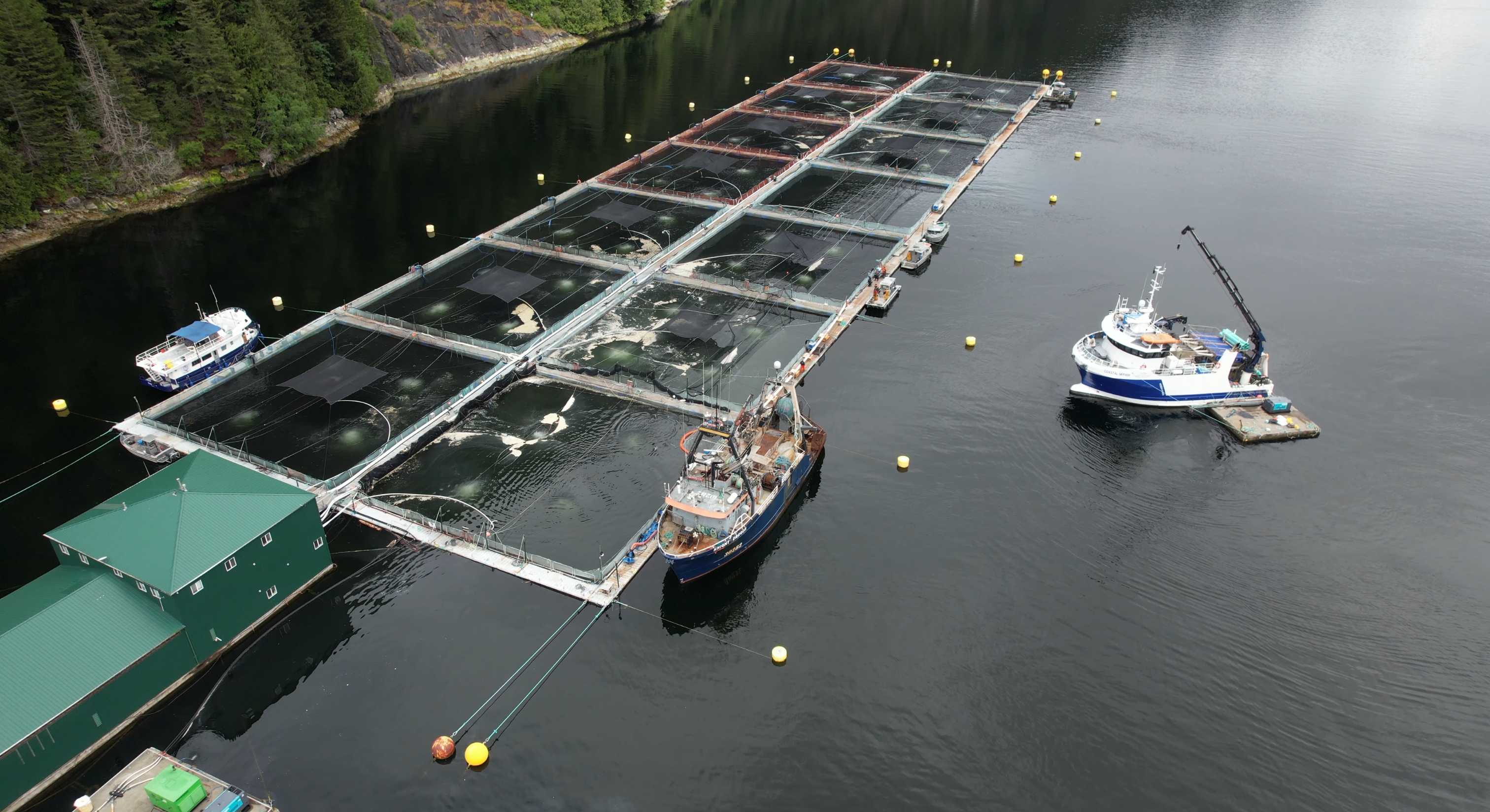
McCorquodale further wrote, “DFO staff have attended a number of sites and have confirmed that the likely cause of these mortalities is very low levels of dissolved oxygen and presence of plankton in the marine environment.” Regarding the discharge being pumped into the inlet, she added that DFO is currently investigating the issue and could not comment further.
Grieg Seafood released a statement saying the low oxygen levels were due to a naturally occurring event which, in addition to the presence of harmful plankton, impacted the health of the salmon. Because of these conditions, they were “unable to handle and perform sea lice treatments during this time, resulting in higher-than-normal sea lice counts for a short period of time,” they wrote. They did not add any additional information about the high rates of fish death.
Parasite Problem
Proboszcz said he is skeptical of the DFO’s interpretation of events. “They’re a bit of a captured agency,” he said, referring to the recently launched investigation into DFO allegedly muzzling its scientists from publicly communicating about fish farm science that could be detrimental to the aquaculture industry.
He also said the reported low oxygen levels were confusing to him as the video clearly shows a bubbling system intended to oxygenate the fish pens. “So if they’re dying of low oxygen, but they have these bubblers, you have to turn it around and say, well, something isn’t working here with this technology if almost a quarter of your fish died. Do you have too many fish in the farm? Is this even the right technology to be using when you have these die-offs on a semi-regular basis?” he asked.
“I witnessed them essentially using our coastal waterways as a sewer. I just experienced a mass mortality event and this is how the industry operates on BC Wild Salmon Day.”
Stan Proboszcz, Senior Science and Policy Analyst at Watershed Watch Salmon Society
Proboszcz is also concerned about the lack of veterinarian reports or third-party testing for parasites, which he suspects is related to the high die-off rate. “Did they test for a whole slew of viruses and bacteria that commonly infect farm fish? I’m not really sure. They didn’t provide any evidence of negative tests,” he noted.
He pointed to nearby farms that have alarmingly high figures of parasites. The allowable limit by DFO is an average of three motile lice per farm fish. Grieg Seafoods’ own reports show their Concepcion farm, a few kilometres from Muchalat North in Nootka Sound, has a sea lice infection rate of 34.55 motile lice per fish as of June 2 – over ten times the limit.
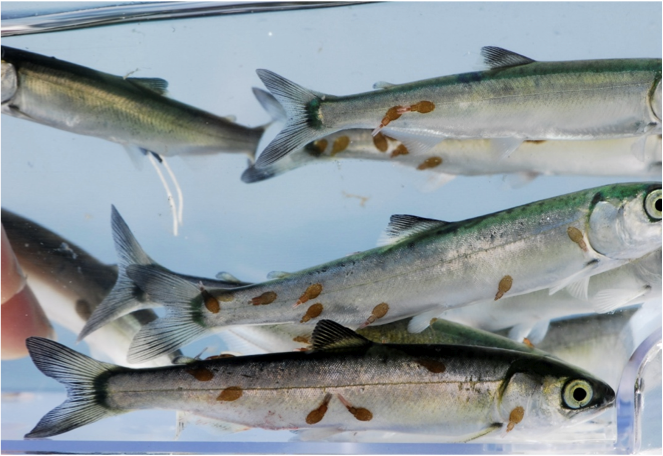
“This is a perfect example of how the industry currently operates. I witnessed them essentially using our coastal waterways as a sewer. I just experienced a mass mortality event, and this is how the industry operates on BC Wild Salmon Day,” he said.
Awaiting a Transition Plan
Meanwhile, the deadline looms for a federal transition plan to close BC’s fish farms. Open-net fish farm licenses are set to expire in the province on June 30, 2024, and no date has been given for the release of the much-delayed transition plan by Fisheries Minister Diane Lebouthillier.
Fisheries and Oceans Canada released a proposal earlier this year revealing they are considering extending salmon farm licenses for another two to six years. The proposed license changes are directly in conflict with the federal government’s promise to deliver a transition plan to phase out fish farms in BC.
“This is an archaic industry and our neighbours have already taken action to remove Atlantic salmon farming. What are we waiting for?”
Stan Proboszcz, Senior Science and Policy Analyst at Watershed Watch Salmon Society
Proboszcz thinks that time has run out for fish farms in BC. “It’s unbelievable to expect this industry is going to change over time when they’ve been operating like this for decades,” he said. “The transition needs to be expedited, and these farms have to be removed immediately because we’re just going to keep having these problems that continue to put our wild salmon at risk.”
He also points out that BC is the outlier, as states along the Pacific, including Alaska, Washington, Oregon, and California, have banned commercial open-net salmon farms. “This is an archaic industry, and our neighbours have already taken action to remove Atlantic salmon farming. What are we waiting for? Let’s get on with it,” he said.
The Skeena reached out to DFO for further comment but did not hear back by our publishing deadline.


